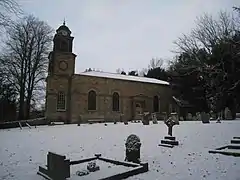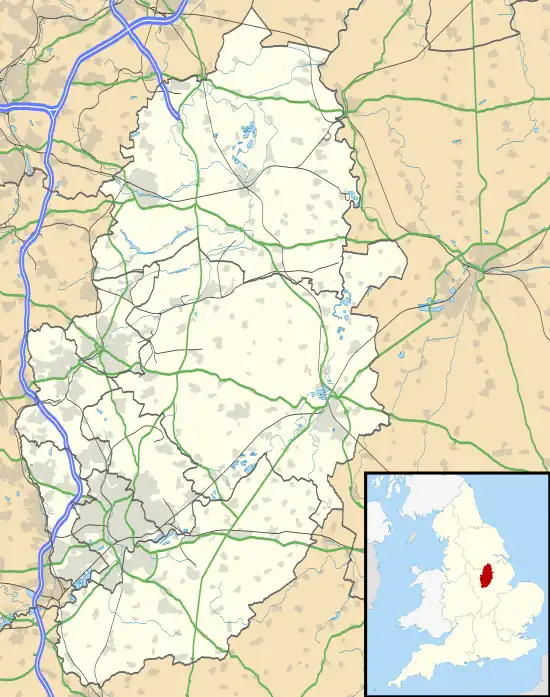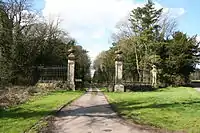Ossington
Ossington is a village in the county of Nottinghamshire, England 7 miles north of Newark-on-Trent. It is in the civil parish of Ossington, but for census purposes its population count is included with the civil parishes of Ompton and Laxton and Moorhouse.[1] It was centred on Ossington Hall, the ancestral home of the Denison family, but the house was demolished in 1964 and all that remains are a few outbuildings and a private chapel that now serves the parish as Holy Rood Church, Ossington. This is a Grade I listed building, originally 12th century and rebuilt in 1782–1783 by the architect John Carr, with minor 19th-century alterations and additions. It includes earlier monuments and stained glass. There is a barrel organ built by Thomas Robson in 1840.
 Church of the Holy Rood, Ossington | |
 Ossington Location within Nottinghamshire | |
| Population | 449 (2011) including Laxton and Moorhouse, with Ompton |
|---|---|
| Civil parish |
|
| District | |
| Shire county | |
| Region | |
| Country | England |
| Sovereign state | United Kingdom |
| Post town | NEWARK |
| Postcode district | NG23 |
| Police | Nottinghamshire |
| Fire | Nottinghamshire |
| Ambulance | East Midlands |
| UK Parliament | |
Ossington Hall
The estate can be traced back to Saxon times, when it was known as "Oschinton" and then later in 1144 as "Oscinton". The lord at that time, Roger de Burun, gave the estate to the Cluniac order of monks, when he entered the order as an act of penitence. He neglected to recall that he had earlier made the property over to the Hospitallers of St. John of Jerusalem. A legal dispute followed between the two religious orders, which the Hospitallers won. They retained ownership until the Dissolution of the monasteries around 1539. The estate was eventually bought by the Cartwright family, of whom there are monuments in the church. The house was damaged during the Civil War and in 1753 passed to William Denison, a merchant of Leeds. He and his brother Robert made substantial improvements. William was appointed High Sheriff of Nottinghamshire for 1779.[2]
The house was then inherited by Denison's nephew, John Wilkinson, who changed his name to Denison and made further improvements to it. John Denison's heir was his eldest son, John Evelyn Denison (1800–1873), Speaker of the House of Commons, who held the estates from 1820 until his death in 1873, and was created Viscount Ossington in 1872. After his death with no direct heir, the estate passed to William Evelyn Denison (1843–1916), William Thomas Denison, son of Ossington's brother, and after him to a cousin, William Frank Evelyn Denison, who died two years later. The estates then reverted to Elinor Denison, widow of William Evelyn Denison, until her death in 1939, when it devolved on William Frank Evelyn Denison's cousin, William Maxwell Evelyn Denison (1904–1972).[3]
Air base
During the Second World War a large Royal Air Force station known as RAF Ossington was laid out on land close to the Ossington estate. It opened on 18 January 1942 as the base for No. 14 (Pilots) Advanced Flying Unit and was transferred to No. 93 (Training) Group RAF Bomber Command in 1943. In January 1945 it was finally transferred to RAF Transport Command No. 6 Lancaster Finishing School, before it was closed in August 1946. The hall formed part of the accommodation for the airfield.
Demolition
After the Second World War, the hall fell into disrepair and was demolished in 1964. An urn from the estate survives in the grounds of Flintham Hall. Some other outbuildings and a small well remain.

See also
- John Denison of Ossington (c. 1758 - 1820}, father of Viscount Ossington
- John Evelyn Denison, 1st Viscount Ossington
- William Evelyn Denison
- George Anthony Denison
- Listed buildings in Ossington
- Ossington Street
- Ossington Avenue
References
- "Custom report - Nomis - Official Labour Market Statistics". www.nomisweb.co.uk. Retrieved 10 November 2020.
- Ossington Holy Rood, History Southwell and Nottingham Church History Project. Accessed October 2014.
- "Denison Family of Ossington". Retrieved 27 March 2013.
External links
![]() Media related to Ossington at Wikimedia Commons
Media related to Ossington at Wikimedia Commons
- Ossington history in About Nottinghamshire: Its Places And Its People, By Cornelius Brown, F.R.S.L., Nottinghamshire Guardian (1889)
- Ossington history in Autumn excursion, Transactions of the Thoroton Society, (1902)
- Photo of Ossington Hall in 1913 Francis Frith
- The papers of the Denison estate held by The University of Nottingham
- RAF Ossington The Wartime Memories Project – RAF Ossington